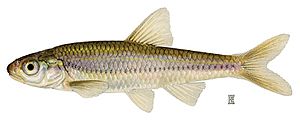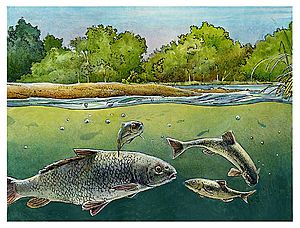Sand shiner facts for kids
Quick facts for kids Sand shiner |
|
|---|---|
 |
|
| Conservation status | |
| Scientific classification | |
| Synonyms | |
|
The sand shiner (Notropis stramineus) is a small freshwater fish found across North America. It belongs to the Cyprinidae family, which includes minnows and carps. These fish love clear streams with sandy bottoms. They often swim together in groups, called schools. Sand shiners eat tiny water insects, land insects, and even tiny plants called diatoms.
Contents
Where Sand Shiners Live
The sand shiner lives in many places. You can find them in the central United States and southern Canada. Their home range stretches from the St. Lawrence-Great Lakes area. It also includes the Hudson Bay and Mississippi River basins.
They live as far north as Quebec and Saskatchewan in Canada. To the south, they reach Tennessee and Texas. Westward, they are found in Montana, Wyoming, Colorado, and New Mexico. Their range goes from the Trinity River to the Rio Grande in Texas and New Mexico, and even into Mexico.
What's in a Name?
The name Notropis means "keeled back." This refers to the shape of the fish's back. The second part of its scientific name, stramineus, means "of straw." This describes the fish's light, pale amber body color.
There was another name for this fish, Neotropis ludibundus. However, scientists decided to keep N. stramineus as the official name.
How Sand Shiners Look
Sand shiners have a thin, flat body. It is covered in smooth, round scales called cycloid scales. Their mouth is slightly under their snout. Their tail fin is shaped like a fork, with both halves being the same size.
These fish usually have seven soft rays in their anal fin. They have fewer than 10 soft rays in their dorsal fin (the one on their back). They also have fewer than 45 scales along their lateral line. None of their fin rays are hard or spiny. They have special teeth in their throat, called pharyngeal teeth, with a count of 0,4-4,0.
An average sand shiner is about 44 millimeters (about 1.7 inches) long. The longest ones can reach about 82 millimeters (about 3.2 inches). Their head and sides are shiny silver. A dark stripe runs down their back to the dorsal fin. At the base of the dorsal fin, you can see two small black marks with a clear space between them.
Their back scales are olive-colored. They have dark spots, called melanophores, outlining each scale. The pores along their lateral line system also have these dark spots. This makes it look like they have a thin stripe along their side. Their belly is whitish. They have faint spots at the base of their tail fin. During spawning season, the males' colors become much brighter.
Where Sand Shiners Live
Sand shiners need clear water to survive. They prefer streams with sandy, gravelly, or rocky bottoms. You can find them in many different sizes of streams and rivers. However, they are rarely found in high-land areas.
These fish usually look for water deeper than 20 centimeters (about 8 inches). They like places with few or no water plants and a slow-moving current. They avoid water that is too acidic or too alkaline. But in the Southwest, they can live in streams with a pH around 8.0.
Their favorite spots change a little with the seasons. In August, during spawning season, large groups of sand shiners gather in shallow water. This water has a gentle current and a sandy bottom. In the fall, many sand shiners can be found in deep pools. In late summer and fall evenings, they tend to move into shallow water over rocky bottoms.
What Sand Shiners Eat
Sand shiners are omnivores. This means they eat both plants and animals. They feed on insects that live in the water and insects that fall from land. They also eat tiny bits from the bottom of the stream and diatoms. You often see them in large schools, feeding in shallow water.
They are "opportunistic feeders." This means they eat whatever food is available. They mostly eat small particles from the bottom. They also eat plant material and both water and land insects.
In summer, their diet mainly includes:
- Bottom ooze (about 68% of what they eat)
- Water insects like larvae and nymphs
- Mayfly nymphs
- Caddisfly larvae
- Adult land insects
- Adult and emerging mayflies
- Flies
- Water bugs called corixids
- A small amount of plant material
In late summer, sand shiners start feeding more on the surface. They eat adult water and land insects. Their eating habits are similar to their relatives, the Cape Fear shiner and the swallowtail shiner.
Conservation Status
The number of sand shiners in the southern United States is currently stable. The U.S. federal government does not list them as endangered. No state governments currently list them as endangered either.
However, the state of New Mexico gives them some protection. This is because their numbers in the Pecos River have dropped sharply. This decline is partly due to how water is managed in that area.
Reproduction and Life Cycle
Sand shiners reproduce from May or June through August. The exact timing depends on how far north or south they live. The busiest time for spawning is in July and August. This is when the water temperature is high (27-37 °C) and there is little rain. Low water levels also help.
Scientists believe that spawning during the hot, dry summer helps the young fish survive. Sand shiners are "broadcast spawners." This means they release their eggs into the water. The eggs are "demersal," meaning they sink to the bottom. They are also "adhesive," so they stick to loose gravel. They do not float.
After hatching, young sand shiners grow the most during their first year. When they are about 10.5 millimeters long, their scales start to form. Fish can start to spawn when they are one or two years old. One-year-old fish are usually more numerous.
A female sand shiner can lay between 150 and 1,000 eggs each year. Older and longer fish tend to lay more eggs. The eggs are small, about 0.75 to 0.95 millimeters wide. On average, a sand shiner lives for about three summers.
- Robert Jay Goldstein, Rodney W. Harper, Richard Edwards: American Aquarium Fishes. Texas A&M University Press 2000, ISBN: 978-0-89096-880-2, p. 94 (restricted online copy at Google Books)
See also
 In Spanish: Notropis stramineus para niños
In Spanish: Notropis stramineus para niños



